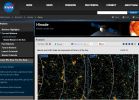ISWI Newsletter - Vol.4 No.45
22 April 2012
Dear ISWI Participant:
About every 11 years, the sun's magnetic field does a complete reversal.
North becomes south, and south becomes north. However, as the two attached pdf items point out, it is a rocky transition.

The first pdf is from yesterday's front page of "The Daily Yomiuri", an English-language newspaper in Japan. For this newspaper, it was the top news of yesterday -- as you can see. The article was placed right under the newspaper's masthead -- the best possible location for a newspaper article.

The second pdf is from a NASA website. It was sourced from www.nasa.gov/mission_pages/hinode/news/pole-asymmetry.html and so you are invited to access it directly. (This info came to me courtesy of Dr Nat Gopalswamy of NASA at Goddard Space Flight Center in Greenbelt, Maryland, where I grew up til age 21).
Both pdf items refer to a satellite called "Hinode", which is a Japanese word. It is pronounced "hi no deh", and it means "day break" or "sunrise".
| The following basic explanation is from Wikipedia: |
Hinode (Japanese: |
| This mission explanation is also from Wikipedia: |
|
Mission: Hinode was planned as a three-year mission to explore the magnetic fields of the Sun. It consists of a coordinated set of optical, extreme ultraviolet (EUV), and x-ray instruments to investigate the interaction between the Sun's magnetic field and its corona. The result will be an improved understanding of the mechanisms that power the solar atmosphere and drive solar eruptions. NASA, the space agency of the United States, developed three science instrument components: the Focal Plane Package (FPP), the X-Ray Telescope (XRT), and the Extreme Ultraviolet Imaging Spectrometer (EIS) and shares operations support for science planning and instrument command generation. |
|
Respectfully yours, George Maeda Editor of ISWI Newsletter Hakozaki Campus, Kyushu University, Japan. |
Attachments:
(1) The Daily Yomiuri front page April 21, 2012 ![]() )
)
(2) Hinode and SOHO Paint An Asymmetrical Picture Of the Sun pages on NASA web ![]() )
)